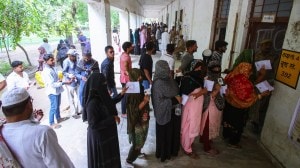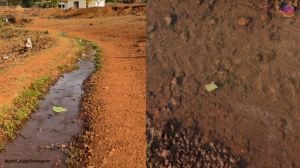- India
- International
How Odisha took bite out of malaria: strategy and ASHA soldiers on ground
Surveying the period between March 2015 and March 2019, this year’s Economic Survey also stated that “malaria cases improved significantly...after implementation of Swachh Bharat Mission (SBM)”.
 ASHA worker Gitanjali Bhakta (left) performs a malaria blood test in Lokapada village of Boudh district. (Express photo by Sampad Patnaik)
ASHA worker Gitanjali Bhakta (left) performs a malaria blood test in Lokapada village of Boudh district. (Express photo by Sampad Patnaik)
From 4,36,850 malaria cases reported in 2015, Odisha had 66,301 cases reported in 2018, an 85-per cent reduction, giving the eastern coastal state the honour of reporting the highest reduction in malaria cases across the country, according to data from the Health Ministry’s National Vector Borne Disease Control Programme.1
Surveying the period between March 2015 and March 2019, this year’s Economic Survey also stated that “malaria cases improved significantly…after implementation of Swachh Bharat Mission (SBM)”.
The Survey states that Odisha brought about the highest reduction in malaria cases among children below five years but also notes that “major focus of SBM has been on making villages Open Defecation Free (ODF)”.
Senior professionals in the state, however, disagree with the analysis. “There is no scientific link between controlling malaria and building toilets,” said Dr Pramila Baral, state director, National Vector-Borne Disease Control Programme (NVBDCP).
“It is entirely due to the state government efforts, its political and bureaucratic commitment, and ASHAs on the ground,” she emphasised.
How it was achieved

The state government relies on a three-step project to keep malaria in check, executed by 47,147 ASHAs trained in diagnosing and monitoring malaria treatment. In the Early Detection and Complete Treatment (EDCT), an ASHA tests any fever case for malaria — so that treatment begins early and the parasite is killed before mosquitoes spread it.
Odisha also runs a programme called DAMAN — Duragama Anchala Re Malaria Nirakaran (or controlling malaria in remote locations) — as part of which mass screenings are organised twice a year at ‘malaria camps’ in these areas: in April-June, and September-October. Under DAMAN, the entire population of these areas undergoes a malaria test, irrespective of whether one has fever or malaria symptoms. Indoor residual spray method is used, in which a residual insecticide is applied to inner walls and ceilings of houses so that malaria vectors come in contact with the insecticide.
Flip side of success
While successful test helps an ASHA get Rs 75, just testing, and achieving a negative result, fetches her only Rs 15 per case. As negative cases rise, malaria supervisors in Odisha worry whether the lower pay will demotivate ASHAs to work with equal fervour — or, worse, whether false cases will be reported to game the payment structure. Nine ASHAs in different low-endemic districts admitted that as negative tests keep increasing, the associated lower payment is a disincentive for them to continue testing each case of fever for potential malaria.
Third, the state government has distributed nearly 1.1 crore long-lasting insecticide nets (LLINs) to combat malaria exposure during sleep. ASHA workers go door-to-door to explain nuances of the net’s use.
“For example, LLINs must not be washed with soap water. They should be hung even at day so that mosquitoes that come in contact with the insecticide die throughout the day,” said Swati Kumhari, vector-borne disease consultant for Boudh district, around 200 km to the west of state capital Bhubaneswar.
When The Indian Express visited Lokapada, a village in Harbhanga block of Boudh, ASHA Gitanjali Bhakta, 35, performed a Rapid Diagnostic Kit (RDK) malaria blood test on Arati Dehury, 60, under EDCT programme. Relying on antigen antibody interactions, RDKs are useful in places lacking quality microscopy services.
For a positive test result, Gitanjali has to ensure the patient takes the prescribed medication lasting between three and 14 days, depending whether the detected parasite is plasmodium falciparum or plasmodium vivax. She earns Rs 75 per case for the whole process — from detecting a positive case to completing the course of treatment.
Apr 26: Latest News
- 01
- 02
- 03
- 04
- 05








































